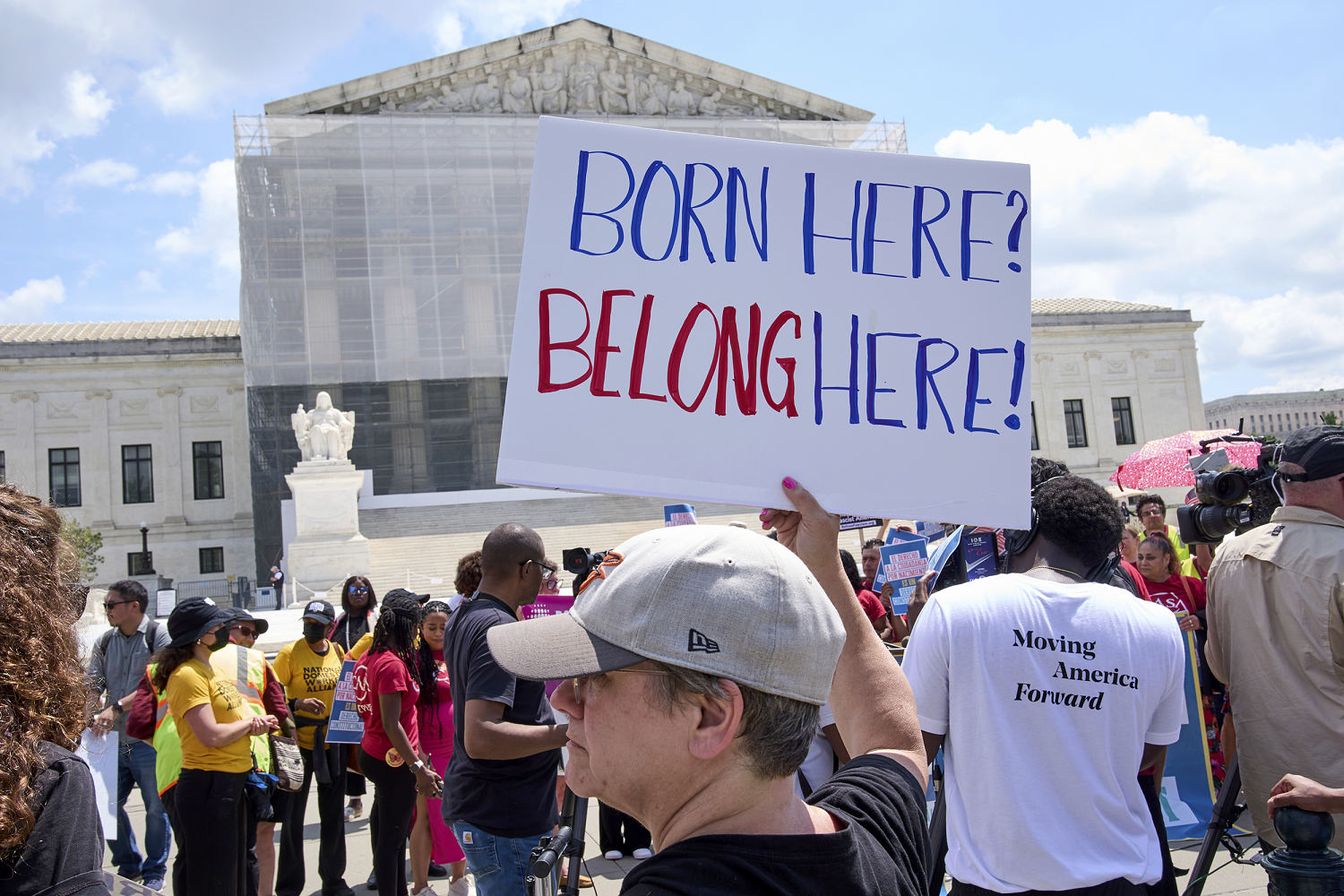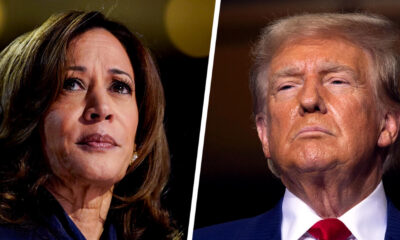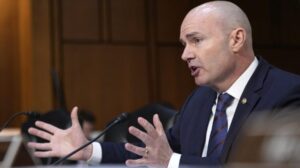The Dictatorship
How a little girl at a Minnesota ‘No Kings’ protest and rally summed up a horrible day

I was almost giddy Saturday morning while driving to the “No Kings” rally in my west central Minnesota town of Alexandria. I had reason to hope that Indivisible, which had planned the rallywould turn out 1,000 protesters in Douglas County, despite our county having voted for Donald Trump by a two-to-one margin. And I was still replaying in my head the events of Friday night, when my wife and I attended the annual Minnesota DFL (Democratic-Farmer-Labor) Humphrey-Mondale Dinnerwhere Gov. Tim Walz, Sens. Amy Klobuchar and Tina Smith and others spoke.
I was still replaying the events of Friday night, when my wife and I attended the Minnesota DFL (Democratic-Farmer-Labor) Humphrey-Mondale Dinner.
My hoping for a good turnout and my replaying the previous night’s speeches in my head was violently interrupted by a news report on the radio that Minnesota House Speaker Emerita Melissa Hortman and her husband, Mark, had been fatally shot in their home in Brooklyn Park and that state Sen. John Hoffman and his wife, Yvette, had also been shot.
More than a 1,000 people did show up at Alexandria’s Veterans Memorial Park, Indivisible estimated, most of whom didn’t know that DFL lawmakers had been killed and wounded until it was announced over a loudspeaker.
Minnesota is not a place where grief gets loud. The crowd fell silent at the news of the politically inspired killings, and I saw people holding quiet conversations with one another. We collectively observed a moment of silence for the victims. Then we fanned out along Alexandria’s main street. As we stood and waved, cars honked. Most of them were supportive, a few decidedly were not. We watched the cars pass and talked about Rep. Hortman. Some had met her. Some had worked with her. And all of us shook our heads at a state and country where things like this happen.
There’s a photograph of the Hortmans from Friday night’s DFL dinner; it may be the last photograph for which they ever posed together. They are frozen in that moment, smiling. His collar is open; her jacket is buttoned. I’m somewhere in the blurry background. I never met them. Still, we may have crossed paths unawares. My wife worked at a Brooklyn Park pediatric clinic near the Hortmans’ house. And there’s every chance I saw Hortman at the frenetic Minnesota State Fair DFL booth.
After growing up in Alexandria, I lived most of my adult life in Louisiana; I returned here a few years ago to help my mother, whose health was failing. Over the years, my mom and I shared a love of politics — or at least some politics. Mainly we shared a love of Paul Wellstone, who was campaigning for a third term in the U.S. Senate when he died in a plane crash in October 2002.
Wellstone’s name still inspires Democrats across the state. The DFL’s annual fundraiser might be called the Humphrey-Mondale Dinner, but on Friday night, it seemed to me that Wellstone was quoted the most often. “Thinking about one of my favorite Wellstone quotes today,” Rep. Hortman wrote in a Facebook piece earlier this year, “‘If we don’t fight hard enough for the things we stand for, at some point we have to recognize that we don’t really stand for them.’”
When Gov. Walz was highlighting legislation that had improved the lives of children and families in Minnesota, he was talking about work he’d done alongside Hortman.
In my town, I’m sometimes introduced to a person I don’t know with the endorsement, “That’s a strong DFLer.” Those words mean something about our values and how we live them. Melissa Hortman was a strong DFLer. She was a leader for abortion rights and gender-affirming care. She worked for gun safety legislation. After George Floyd was murdered, she led police reform efforts. When Gov. Walz was running for vice president and highlighting legislation that had improved the lives of children and families in Minnesota, he was talking about work he’d done alongside Hortman.
You could listen to Friday night’s speeches at the Humphrey-Mondale Dinner and know that it was fundraiser for a party that had lost a critical national election and that those who spoke harbored no illusions about how dire things had gotten since then. I was finding it difficult to find any hope until 89-year-old former Minnesota Secretary of State Joan Growe presented an award to Wintana Melekin, a young woman who moved to the U.S. from Eritrea when she was three years old and has become one of the state’s leading advocates for voting rights and social justice. My hope flickered when the two embraced.
Though Saturday’s political violence may threaten to extinguish that hope, I know that tomorrow we’ll get back to work in our local DFL. There’s a table at the Pride festival to staff, a booth at our county fair to set up. There’s a dark hallway in the back of the grandstand where discussions about reproductive freedom can get drowned out by stock car races. Most challenging of all, we need to find candidates to take on Republican incumbents, no matter the odds. Someone who can face a campaign the way Melissa Hortman did, over and over.
Sadness about this morning’s news hasn’t started to settle in, even as a suspect’s name and brief biography begin to emerge. We gathered Saturday morning to protest, among other things, a president who has encouraged and pardoned political violence. Even when hope is elusive, we’ll have to get by on determination.
Near the end of Saturday’s rally, I saw a family with three children walking back to their car. The youngest was still carrying a sign that seemed to sum up this day.
“I deserve better,” it read.
She does.
Minnesota does.
We all do.
Michael Tisserand
Michael Tisserand is a Minnesota-based writer whose works include “Krazy,” a biography of cartoonist George Herriman, and Sugarcane Academy, a memoir of his family’s experiences of Hurricane Katrina. With support from a Guggenheim Fellowship, he is currently writing a book about Charlie Chaplin and “The Great Dictator,” for Oxford University Press.
The Dictatorship
The Supreme Court just fumbled a basic question about birthright citizenship

If you arose Friday morning thinking the U.S. Supreme Court would finally settle the question of birthright citizenship, you were disappointed. We know no more now than we did Thursday about how Chief Justice John Roberts’ court regards children born here: The liberal three-justice minority is certain all are citizens, while the conservative six-person majority remained mum. That conservative majority avoided addressing the constitutionality of President Donald Trump’s executive order restricting birthright citizenship and chose instead to reject so-called “universal injunctions” blocking his executive order.
All we learned Friday is that a final resolution to the question of birthright citizenship is somewhere in the distance.
All we learned Friday is that a final resolution to the question of birthright citizenship is somewhere in the distance, beyond many more rounds of court proceedings.
For families directly targeted by Trump’s Jan. 20 executive orderwhich aims to bar children born to nonpermanent residents from automatic citizenship, too little has changed. Such families — and especially their yet-to-be born children — remain in the crosshairs of a dispute that will continue unresolved at least for months to come. Going forward, such families will be subjected to harrowing circumstances, not knowing where they stand before the court and the Constitution.
By some accounts, we are five months into this era of uncertainty regarding citizenship. But we have endured years, decades, even centuries of confusion about citizenship.
We know that Trump intended to do away with birthright citizenship seven years ago, even though details were lacking. Consult the Congressional Record, and you’ll discover that the language in Trump’s executive order is similar to the language of bills that have been put forward every session since at least 2003. Scour law review articles and you’ll learn that as far back as the 1980s, some legal scholars have promoted the view that children of noncitizens born in the U.S. cannot be birthright citizens.
This longer view of the dispute over birthright citizenship helps explain why we, in this moment, feel so worn down by the evasion that is Friday’s Supreme Court decision. How long should Americans, especially children born in this country and their families, be expected to endure such indecision, confusion and uncertainty?
Perhaps we should not be surprised to find Roberts’ 21st century court fumbling the birthright citizenship question. Indeed, the origins of birthright citizenship in the United States are in the ignoble ineptitude of lawmakers two centuries ago. In early America, free Black Americans, nonimmigrants, were a despised group, and they were regularly confronted by those who argued that they were not citizens and thus had no rights before the courts or the Constitution.
It was a harrowing existence. In the nation’s early years, the American Colonization Society organized to press free Black Americans to leave the country, to places such as the West African colony of Liberia. The ACS outfitted ships, funded travel and encouraged Black Americans to self-deport, all to preserve the U.S. as a white man’s country. State lawmakers and local officials played their part, enacting so-called Black laws that constrained everyday life — where they worked and worshipped, how they traveled and raised their children — all to further encourage free Black Americans to leave.
Were free Black Americans citizens? They believed so and looked to the terms of the Declaration of Independence and the Constitution for authority. All men were created equal, they insisted. The Constitution recognized birthright citizenship and drew no color line, they urged. Today, we can read their ideas in early American newspapers, pamphlets and books. They are to be credited with promoting the terms of their own belonging, and those of all persons born in the United States. Their rallying cry: Citizenship in the U.S. was the result of birth, no more and no less.
Early American lawmakers failed Black Americans, leaving them to make families, lives and communities in the face of profound uncertainty.
Early American lawmakers failed Black Americans, leaving them to make families, lives and communities in the face of profound uncertainty. For example, in 1821, when Congress considered admitting Missouri into the Union, lawmakers asked whether Black Americans would have the right to enter the new state. Only if they were citizens, it was said, and a debate ensued with representatives taking both sides. The result was a twisted injustice: Congress never firmly answer the question and instead admitted Missouri while leaving Black Americans mired in ambiguity.
Also in 1821, U.S. Attorney General William Wirt was asked to resolve whether a free Black man could command a ship in Virginia’s coastal waters. The law provided that he could only if he were a citizen. Thus, Wirt was charged with solving the riddle of Black citizenship. But he did not. Instead, he reached a twisted conclusion: In Virginia, a free Black man could not be a citizen, but in another state he perhaps could. Once again, Black Americans were left to make lives under murky circumstances.
Notoriously, in the 1857 Dred Scott casethe U.S. Supreme Court concluded that no Black American could be a citizen. Or at least this is how the story is often told. A closer look reveals that the nation’s high court was deeply divided in that instance. Justice Roger Taney was sure that Black Americans were not birthright citizens. Still, his fellow jurists, Associate Justices Benjamin Curtis and John McLean, took the opposite view. Birthright, they concluded, was the law of the land and, absent a color bar in the Constitution, Black Americans, like their white counterparts, were citizens. The high court failed to settle much at all. Black Americans might be citizens to some, but to others they were subject to Black laws and colonization.
It would take a Civil War and a remaking of the Constitution during Reconstruction to settle debates over Black citizenship. The 14th Amendment constitutionalized the birthright principle that Black Americans had long championed. Along the way, Black Americans learned hard lessons, and so should we. The nation’s founding documents can be subjected to interpretation and reinterpretation in the hands of lawmakers, courts and the executive branch. Those designated as despised can be variously regarded as citizens and noncitizens, while lawmakers fumble and fail to settle the debate.
Those designated as despised can be variously regarded as citizens and noncitizens, while lawmakers fumble and fail to settle the debate
Most of all, by recalling the struggles of Black Americans for birthright citizenship, we better understand that uncertainty before the law is its own form of inhumanity. Being the object of debate is its own sort of harrowing existence. In early America, Black Americans made homes, raised children, established businesses and built a political culture — all the while facing down efforts to banish, exile or otherwise remove them from the nation. We rightly admire their courage and persistence. At the same time, we can recognize the price they paid for being subject to the deliberations of lawmakers who avoided, sidestepped, punted and otherwise refused to settle their status as birthright citizens.
Friday, the nation’s high court fumbled. Rather than affirm the birthright principleit put that question off for another day. In the months ahead, there will be briefs filed and arguments presented. At the same time, there will also be harrowing days ahead for immigrant Americans and their children, people who urgently await a determination of their standing as birthright citizens before the Constitution.
As a nation, we owe them at least that.
Martha S. Jones
Martha S. Jones is the Society of Black Alumni President Professor and Professor of History at The Johns Hopkins University. She is author of the prize-winning “Birthright Citizens: A History of Race and Race in Antebellum American” (2018, Cambridge University Press.) She is also the author of an amici cruise brief on the subject of birthright citizenship along with historian Kate Masur.
The Dictatorship
What this congressman’s shockingly racist post says about bigotry in Trump 2.0

If there is a defining characteristic of President Donald Trump’s second term — aside from shameless self-enrichment out of the executive branch — I’d argue it’s the proliferation of unabashed and outspoken racism espoused by the president and many of his most loyal followers.
The online attacks launched by Rep. Andy Ogles, R-Tenn., against New York City mayoral candidate Zohran Mamdani demonstrated this in stark relief, such as here:
As did many of the other GOP responses to Mamdani’s Democratic primary victory this week, which my BLN colleague Steve Benen highlighted for MaddowBlog. This reactionary post from Charlie Kirk, which reads like Ku Klux Klan propaganda, is a prime example:
During a recent conversation with MSNBC’s Chris Hayesauthor Ta-Nehisi Coates said that one of the Civil Rights Movement’s greatest successes has fallen apart in the Trump era: People no longer feel ashamed to express “open bigotry.” Coates added that one of Trump’s most successful political instincts has been his bet that conservative voters are broadly more comfortable with the racist rhetoric that previous Republicans have flirted with a bit more obliquely.
Indeed, this administration has spent its opening months seemingly grooming the MAGA movement to be OK with blatant racism — or, at minimum, accept it as a natural part of political discourse. Even when compared with Trump’s first administration, which promoted diversity programs and parted ways with a speechwriter after it was revealed he spoke at a conference attended by white nationalists, Trump 2.0 has been far more permissive of unabashed bigotry.
Indeed, this administration has spent its opening months seemingly grooming the MAGA movement to be OK with blatant racism.
Trump welcomed the aforementioned speechwriter, Darren Beattie, into his second administration despite the fact that he wrote last year that “competent white men must be in charge if you want things to work.” Trump’s administration rehired after initially firing a Department of Government Efficiency staffer who had called for the normalization of Indian hate. And a host of other figures in the administration have a history of promoting various other blatantly bigoted ideas.
Trump himself has peddled false claimsspread broadly by white nationalists, that white people are facing systemic oppression in South Africa, and he has targeted an exhibit at the Smithsonian American Art Museum that discredits racist pseudoscience. Trump’s Department of Homeland Security itself has spread propaganda promoted by overtly racist social media accountsand his White House has frequently relied on cruel memes meant to dehumanize and mock nonwhite immigrants.
To be clear, MAGA racism is not a new phenomenon. But the president certainly seems to have given his followers a green light to embrace and express any racist hate they may be feeling. And all of this has the feel of a far-right psyop — as if the administration is attempting to train Americans’ gag reflexes in such a way that grotesque exhibitions of bigotry that may have made them squeamish in the past no longer do so.
The Dictatorship
Trump might give away access to your 401(k) retirement funds

The private equity industry wants to get into your 401(k). The industry is lobbying the Trump administration to issue an executive order that would open the way for retirement plans to add private equity investments. The effort brings to mind Groucho Marx’s famous observation“I don’t want to belong to any club that will accept me as a member.” Why would this supposedly elite investment class want the Trump administration to make it easier for small-time savers to invest in their offerings?
The answer, as you might suspect, is nothing good.
Before I proceed further, some explanations are in order. Private equity consists of companies and other investments controlled by private firms, which are almost always acquired with significant amounts of debt — hence the term “leveraged buyout.” The stated idea is to buy a company, overhaul its underlying finances, and then sell it again within a few years at a profit.
The private equity industry boomed following the 2008 financial crisis, when consistently low interest rates facilitated mergers and acquisitions. While the industry blamed then-Federal Trade Commission Chair Lina Khan and the Biden administration’s tougher antitrust enforcement for the end of the M&A boom, the real culprit was the return of high interest rates and private equity shops overvaluing their holdings. Unable to sell many of their holdings at the price they would like, and short of traditional institutional investors in their funds, where can private equity turn? I’m afraid that this is where you enter the picture.
The industry has every reason to expect help from this White House. Republicans in Congress have already placed a provision in Trump’s big, beautiful budget bill that would increase the tax break for interest payments on the leveraged buyouts that private equity loves. And toward the end of Trump’s first term, his administration loosened regulations surrounding 401(k) accounts, agreeing with industry lobbyists that the arena met the standard of a “prudent” investment for retirement savers.
To be clear, in the view of many, it is not. The Biden administration, for instance, backtracked on much of the previous Trump-era guidance. And employers, who are considered fiduciaries for worker retirement accounts and can find themselves in court battling their former employees if things don’t work out, didn’t exactly race in to offer up private equity offerings in 401(k) accounts.
Champions of private equity claim that with promising startups and other companies less likely to go public than in the past, private equity could give mom-and-pop savers access to greater diversity in their portfolios as well as the possibility of higher returns.
The reality is different. The industry is famously opaque, and its high fees cannibalize much of the gains. “PE funds may look good on paper since they place a high value on their unsold companies, but this is not money that investors can take to the bank,” says Eileen Appelbaum, the co-director of the Center for Economic and Policy Research. “Since mid-2022, the companies in private equity portfolios have been overvalued, and PE funds have been unable to sell them at the price they are demanding.”
The result is a poor investment — except for the fat cats collecting management fees on it, that is. A recent analysis found that the S&P 500 returned better results than private equity over a one-, three-, five-, and 10-year period. Multiple other studies have yielded similar results.
Compounding this: The private equity model can be horrible for consumers and employees of the companies acquired and owned in this fashion. That’s because the debt to acquire the company isn’t the responsibility of the private equity firms, their partners or principals. It is, instead, a dead weight on the books of the company unfortunate enough to be purchased in this way, often leading to service and staff cutbacks, price increases and selling off companies piecemeal.
Private equity-controlled companies are more likely to declare bankruptcy than those with different ownership structures, and those filings are hovering at record rates. Of the 10 largest corporate bankruptcies in the first quarter of 2025, seven companies were owned by private equity. Think Forever 21. Think Joann, the fabrics and crafts chain. Think Prospect Medical Holdings, which owns more than dozen hospitals. In fact, health care companies controlled by private equity charge higher prices, yet their patients have higher rates of accidents, complications and deaths.
In other words, private equity all too often acts as an economic scavenger and parasite. The efficiencies of scale the industry claims it can find can literally be deadly. And for what? To make some fabulously wealthy members of the investment class even wealthier?
Nonetheless, now with Trump back in the White House, the financial services industry is racing in to make private equity in your retirement accounts a reality. Earlier this week, BlackRock announced it was debuting a target date fund that would include stocks, bonds and private equity and credit investments. This follows similar moves by State Street and retirement plan provider Empower.
Again, none of this is appropriate for savings that are supposed to let Americans enjoy a stable retirement. This won’t end well — for you, that is. Private equity is a club, and you don’t want it to accept you as a member.
Helaine Olen is a managing editor at the American Economic Liberties Project. She is the author of “Pound Foolish: Exposing the Dark Side of the Personal Finance Industry” and a co-author of “The Index Card: Why Personal Finance Doesn’t Have to Be Complicated.” She has been a columnist for The Washington Post and Slate, and her work has also appeared in numerous other publications, including The New York Times and The Atlantic.
-

 The Josh Fourrier Show8 months ago
The Josh Fourrier Show8 months agoDOOMSDAY: Trump won, now what?
-
Uncategorized8 months ago
Bob Good to step down as Freedom Caucus chair this week
-

 Politics8 months ago
Politics8 months agoWhat 7 political experts will be watching at Tuesday’s debate
-

 Politics8 months ago
Politics8 months agoHow Republicans could foil Harris’ Supreme Court plans if she’s elected
-
Economy8 months ago
Fed moves to protect weakening job market with bold rate cut
-
Economy8 months ago
It’s still the economy: What TV ads tell us about each campaign’s closing message
-

 Politics8 months ago
Politics8 months agoRFK Jr.’s bid to take himself off swing state ballots may scramble mail-in voting
-
Uncategorized8 months ago
Johnson plans to bring House GOP short-term spending measure to House floor Wednesday









